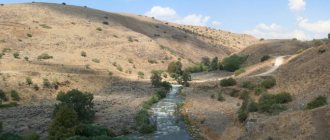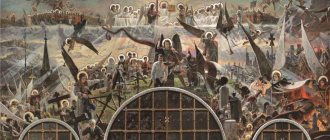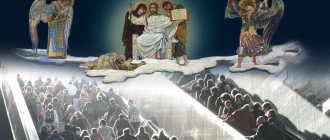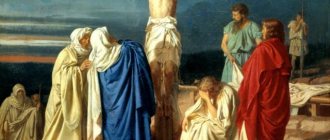Biography of Jesus Christ
Jesus Christ is the central figure in the Christian faith. For Christians, this person is the King of the world, one of the hypostases of God, the Savior who appeared in the flesh and atoned for the sins of people.
Image of Jesus Christ
The Bible says that he was a perfect, sinless, immaculately conceived God-man, a miracle worker, a healer, the head of the Kingdom of God he created, the Church, the founder and main character of a religious cult, who died, was crucified on the cross, and then resurrected. At the end of time, he will return to judge the world, after which all the saved will live and rejoice on Earth forever.
His life path and purpose are set out in the Gospels. In Islam he is recognized as a prophet, one of the messengers of Allah, in Judaism he is referred to as the False Messiah (since in the holy book of the Torah, one of the signs of the coming of the true Messiah is the end of all wars, the disappearance of evil and crime).
Jesus was accused of calling himself the King of the Jews
Since Judea was under the rule of Rome, only the local government representative, the procurator Pontius Pilate, could decide on execution issues. It was necessary to come up with a sufficient charge for the prosecutor to impose a death sentence.
Christ was accused of calling himself the King of the Jews.
Such an act, according to Roman law, was considered a serious crime.
A short dialogue took place between Christ and Pilate:
-Are you the King of the Jews?
- You say.
Pontius Pilate’s question is clear, but what did Jesus say to him? This is the affirmative form of the Hebrew language. That is, He confirmed the accusation. In the Gospel of John, Christ speaks more fully:
In. 18:29–38
“You say that I am the King. For this purpose I was born and for this purpose I came into the world, to testify to the truth.”
To which Pilate exclaims wingedly:
Pontius Pilate
procurator of Judea
"What is truth?"
Christ leaves the question unanswered.
As you can see, there are no deep Bulgakov dialogues from “The Master and Margarita”. This may disappoint some people. Only the apocryphal Gospel of Nicodemus says that the dialogue continued:
"Truth is from heaven." Pilate said to Him: “Is there no truth in earthly things?” Jesus said to Pilate: “Listen - the truth is on earth among those who, having authority, live by the truth and carry out righteous judgment.”
Be that as it may, Pilate did not discover Christ’s guilt and sent him to trial before King Herod, but he only laughed at the fact that the tramp called himself the king of the Jews, dressed him in white robes, as befits a contender for the throne, and returned him to Pontius Pilate.
Pontius Pilate did not find Christ guilty, but could not justify Him.
Twice more the procurator tried to save Christ from His terrible fate:
- Tried to replace execution with beating;
- He suggested that the people, according to tradition, release the prisoner in honor of Easter.
“What is truth?”
Christ and Pilate” - painting by Nikolai Nikolaevich Ge But the Jewish people turned out to be adamant. Pilate could have released Christ, he even stated:
OK. 23:4
“I find no fault in this man.”
But the Jewish high priests could provoke unrest and complain to Caesar about the procurator, so Pilate had to let go and sentence Jesus Christ to death by crucifixion.
But even before his execution, Christ was mocked by Roman soldiers, who inflicted many injuries on the Messiah.
Childhood and youth
Jesus Christ, who became the second person of the triune God, was born in the period from 12 (at the time of one of the passages of Halley's Comet, which allegedly served as a prototype of the Star of Bethlehem) to 4 BC. (then King Herod of Judea died) in the family of an ordinary artisan, carpenter Joseph the Betrothed and the ever-virgin Mary, who came from the House of King David and lived in Nazareth (Northern Palestine). There is no exact date of the birth of Christ in the Bible.
Virgin Mary and Joseph
He was born not as a result of the intimacy of the spouses, but thanks to a miraculous conception through the Holy Spirit. The good news about the greatest event in the life of mankind - the future birth of a son, which became the fulfillment of Old Testament predictions about the coming of the Savior, was announced to them by the Archangel Gabriel.
Jesus is the modern sound of the ancient Hebrew name Yeshua. “Ieh” is the first syllable of the name of the Hebrew god Jehovah, and “shua” means “salvation.” Christ is the Greek equivalent of the Hebrew word “mashiach,” which means “anointed one.”
In the last months of pregnancy, the wives went to Bethlehem, where they were supposed to appear as part of the ongoing census. Due to the large crowd of people who arrived for the census, they could not find a place to stay for the night and were forced to stay in a cave-stable, where the Lord was born next to domestic animals. The newborn baby was glorified by a whole host of angels. Wise men from the East - the Magi - came to worship him. They brought gifts of gold, myrrh, and frankincense and told their amazed relatives that at night they received news of the birth of the Messiah, and a shining star showed the way to him.
Birth of Jesus Christ
On the eighth day, the parents performed the rite of circumcision, giving their son the name Jesus, and on the 40th day, sacrifices were made for the first-born boy in the temple of Jerusalem, where the pious Righteous Simeon blessed him. The meeting of humanity in his person with the Messiah began to be celebrated as the Presentation of the Lord.
Hearing about the mysterious baby, the vicious and cruel ruler Herod I, fearing to lose his throne, ordered the extermination of all male children under 2 years old in the city, hoping that Jesus would be among them. But the holy family, warned by an angel, managed to take him to Egypt.
Virgin Mary with baby Jesus
As the apocrypha testifies, after the death of the king, Joseph and Mary and their son wandered around Galilee. And everywhere they followed the glory of the boy’s miracles: the healing of the suffering, the pacification of wild animals. As a person, he grew up working, helping his father in carpentry. When he was 12 years old, his family visited the Jerusalem Temple with him on Passover. In a conversation with scribes, the teenager surprised them with his deep knowledge of the laws of nature and morality.
As is known, science and the church have always had a difficult relationship. But the warring parties made a compromise. At the end of the 14th century, an unspoken agreement was concluded: knowledge is under the jurisdiction of science, and moral values are given to religion.
Common sense imperatively dictates that science and religion must stick together, otherwise a person will never “get to the bottom” of the truth. But our knowledge is still very, very limited. So we still don’t know when the founder of the Christian religion, Jesus, was born? How old was she at the time of crucifixion? Why did he die?
When was the Messiah born?
In any scientific discipline, as is known, proof is decisive. Meanwhile, history as a scientific discipline, due to subjective and objective reasons, still stands apart. Despite this, the need for evidence in history has always been felt. However, how can this problem be practically solved? How can we eliminate the possibility of various types of falsifications? There is a way out of a seemingly deadlock situation. History must actively apply the achievements of other sciences. With this in mind, let's get down to business.
So, no one knows exactly when Jesus was born. For a long time, Bible scholars, trying to determine the date of birth of Jesus, reasoned as follows. He was born in Bethlehem no later than 4 BC, since the death of Herod the Great (1st century BC), during whose reign Jesus was born, dates back to the indicated year.
The parents of the future Messiah, according to the Gospel of Luke, went to this Palestinian city to participate in the census conducted by the Romans in order to streamline the collection of taxes in Judea. According to reliable sources, this event was carried out by the Roman procurator Quirinius in 6 or 7 BC. As we see, the exact date (year) of the Savior’s birth cannot be determined in this way.
By the way, the day of the Nativity of Christ is even less definable. In the East, it began to coincide with December 25 only at the end of the 4th century. In Rome, this date was adopted to supplant the pagan holiday of the Nativity of the Invincible Sun, and not on the basis of church tradition, which considered January 6 to be Christmas Day.
But astronomers came to the aid of historians. The Gospel of Matthew, one of the earliest accounts of the life of Christ, says: “Where is he born King of the Jews? for we saw His star in the east and came to worship Him” (2:2) Researchers have tried to use this story of the Magi and the Star of Bethlehem to pinpoint the exact date of Jesus' birth. As is known, the laws of celestial mechanics are an unusually precise and subtle thing, amenable to mathematical calculations.
The pioneers of this direction were the great mathematician and mystic, one of the founders of modern astronomy, Johannes Kepler. On the night of December 17, 1603, he observed through a telescope the movements of the planets Jupiter and Saturn, approaching the point of astronomical conjunction. A little later Mars joined them. Two years passed, and the scientist saw a new star in the constellation Ophiuchus. And the whole trick was that when two or more planets come very close to each other, sometimes even merging into one, the earthly observer sees a bright light in the sky.
Guided by an ancient rabbinic commentary on the book of the prophet Daniel, which indicated that the conjunction of Jupiter and Saturn in the constellation Pisces was especially significant for the Israelis, Kepler put forward a hypothesis - the Magi were eyewitnesses of the described phenomenon. According to mathematician calculations, the conjunction of the planets should have happened in 7 BC. He concluded that this was the date of the Immaculate Conception, and that the Nativity took place in 6 BC.
Much later, in the middle of the 20th century, Dr. David Hugers, lecturing on astronomy at Sheffield Albion University, obtained different results. Using the information from the Gospel, he made an assumption - the Bethlehem star is nothing more than a comet.
However, the English astronomer Chris Clayton seems to have come closest to solving the mystery of the birth of Jesus. Ultra-modern technology helped her in this. In 1998, using a Rutherford–Appleton Laboratory supercomputer, he painstakingly calculated the trajectories of the planets of the Solar System over the last two millennia. And I discovered something interesting! It turns out that in June 2 BC. e. Jupiter and Venus came so close to each other in the sky that for the naked eye of an earthly observer they would probably have merged into one unusually bright star.
It was this astronomical event, according to Clayton, that formed the basis of the biblical tale of the Star of Bethlehem. This is what the Evangelist Matthew wrote about this: “And this star, which they saw in the east, went before them, and at last it came and stood over the place where the Child was” (2:9).
Thus, the “Christmas star,” firstly, was not a star at all; secondly, it was not a comet, as previously assumed; thirdly, it did not ascend into the sky in December, as is commonly believed according to Christian tradition.
How old was Jesus at the crucifixion?
According to widespread opinion among believers, Jesus lived for 33 years, of which the last 3 years he preached to people the doctrine of salvation. Indeed, the holy evangelist Luke (1st century) writes: “When Jesus began his ministry, he was about thirty years old...” (3:23)
Everything seems to be true, but the apostle and evangelist John the Theologian (1st century) states otherwise in his Gospel: “The Jews said to Him: You are not even fifty years old, and have you seen Abraham?” (8:57)
As we see, there is a clear discrepancy in dates between Luke and John. Which one is right? Until relatively recently, it was considered hardly possible to establish exactly at what age Jesus was crucified. But a researcher from Athens, Nikos Kokkinos, got down to business. By the way, back in 1980, he studied in detail Roman sources and the New Testament and convincingly proved that Christ was crucified in 36 AD. (and not in the 33rd, as is traditionally believed).
After twenty years of research, N. Kokkinos stated - Jesus, in the year of his crucifixion, could not have been a young man of 33 years old. Why, a surprised reader may ask? Yes, the whole point is that in ancient Jewish society only one who had reached at least fifty years of age was considered a religious teacher. This is confirmed by the testimony of Irenaeus of Leon, a disciple of Polycarp, who knew people who saw Jesus Christ with their own eyes. He said that the Savior was about fifty years old when He began to teach people. Similar information is contained in the Gospel of John we have already mentioned (8:57). In another passage of St. John (2:20) writes how the Savior compares his body, and in fact the path of life, with the Jerusalem Temple, which was built “forty-six years.”
The original solution to this problem was proposed by Kokkinos. The Savior said that he and the temple were of the same age - that is, both were forty-six years old. The construction of this building, located in Jerusalem during the life of Jesus, was completed under King Herod in 12 BC. - the first year of Christ's preaching. Thus, according to Kokkinos, it follows that Jesus was crucified in 36 AD. at the age of forty-eight years.
Guided by the theory of the Athenian scientist, Jesus was born in 12 BC. It is interesting to note that after Kokkinos established the last date, he made another interesting discovery. It turned out that in 12-11 the appearance of Comet Halley was observed in the sky.
A completely different way of evidence was presented to the public in 2005 by Romanian astronomers Liviu Mircea and Tiberiu Oproiu. Let us remind readers that the New Testament indicates that Jesus Christ died crucified on the cross, and then resurrected and ascended into heaven. It also says that he passed away on the day after the first night of the afternoon after the spring equinox. According to the Bible, during the execution of the Savior, a solar eclipse occurred. Using this information, astronomers conducted an interesting investigation and established the following.
Between 26 and 25 AD. The full moon occurred the day after the spring equinox only twice: April 7, 30 and April 3, 33. A solar eclipse was observed only in the year 33! It follows that Jesus died on Friday, April 3, 33, at about three o'clock in the afternoon. The Savior has risen on April 5 at four o'clock in the afternoon!
Why did the Savior die?
There are three versions on this matter. In the 20th century, in German concentration camps, people were crucified and observed what happened to them. As it turned out, on the cross a person slowly dies from suffocation. The center of support of the crucified is not the arms and legs, but the chest. Over time, the pectoral muscles become cramped from tension, which makes it impossible to expand the diaphragm and ventilate the lungs, from where air cannot escape.
This is probably how the Savior died, and not from the blow of a Roman soldier’s spear. This point of view is also confirmed by studies of the Shroud of Turin. There is a bloody stain on the outline of the body on the right side in the chest area. The analysis showed that the leaked blood no longer coagulated, as would have happened if a living person was injured. This means that the warrior thrust his spear into the dead body.
According to another version - it was published in 2005 by Israeli scientist Benjamin Brenner - the Savior died from a blood clot that entered the lungs. While working at a medical center in Haifa, Brenner presented his views in a professional journal devoted to thrombosis and other similar problems. As is known from the Holy Scriptures, the death of Jesus occurred relatively quickly - within a few hours after the crucifixion, although with such an execution a person dies a few days later. Another Brenner point: Jesus was a resident of Galilee, where a quarter of the population suffers from thrombophlebia (the tendency of more viscous blood to quickly clot and form clots). So he, too, could be one of them.
Meanwhile, the third version says: The Savior died from great loss of blood. In 1986, an examination of this issue was carried out by the Journal of the American Medical Association.
Who is right? Further research will probably show this. But one thing is clear – it’s too early to draw a conclusion.
Based on RuNet materials.
Source: Author:
based on RuNet materials
Service
At the age of 30, Jesus came to the Jordan to be baptized. During the ceremony, the Holy Spirit overshadowed him, testifying to the favor of the Heavenly Father. From this moment, which became the feast of the Epiphany, Christ was recognized as the Messiah.
Baptism of Jesus Christ in the Jordan River
Then he went to the desert, where he spent 40 days in prayer, fasting and solitude and prepared to fulfill his destiny of atonement through self-sacrifice of human sins. There he fought with Satan, rejecting all his temptations.
Returning from the desert, Jesus began reading sermons, as well as transferring his knowledge to the 12 apostles. He spread the teaching about the Kingdom of God, interpreted Old Testament prophecies, and encouraged mercy, repentance, love, and acceptance of his personality.
To strengthen his faith, he also performed incredible acts - miracles. The first of them was the transformation of water into wine at the request of the mother at a wedding celebration. Subsequently, by the power of God, he healed the hopelessly sick, including the unfortunate leper, cured with one touch, raised from the dead, in particular, the daughter of Jairus in the presence of his parents and three beloved disciples (Peter, James and John), walked on water, stopped a storm on the Sea of Galilee, In an incomprehensible way, he fed 5 thousand people with five loaves of bread and ensured a miraculous catch of fish. All his miracles were imbued with care and deep compassion for people.
Jesus turns water into wine
The Lord instructed people, supplementing the 10 basic laws of Moses with his Beatitudes, the Golden Rule of Morality (about treating others the way everyone would like to be treated), a call not to judge, not to resist evil, etc.
The son of God's popularity grew, although he tried to avoid human glory. However, his activities were accompanied by constant clashes with representatives of the Jewish ruling and religious elite. For example, he denounced the Pharisees for their pride, high opinion of their own righteousness, and contempt for sinners. In addition, many people, languishing under the yoke of Roman rule, wanted Jesus to improve their earthly life. He offered them the salvation of their souls, the renunciation of everything worldly, and they, sick with anger and misunderstanding, considered themselves deceived. They were incited in every possible way to revolt by the Jewish high priests, who called Christ a “false prophet” and intended to deal with him.
There is an opinion that Jesus did not die
Why did he die? Some people are surprised. They have their own interpretations of the events of that terrible Friday:
- Jesus Christ was mistaken for dead, but He came to His senses in the tomb . This version allows skeptics to explain the Resurrection of Christ in the simplest way, without the participation of supernatural forces.
- Instead of Christ, another person was executed . There is a lot of speculation on this topic. The most interesting one is in the Gospel of Barnabas, where suddenly Judas begins to be seen as Christ and is crucified instead of the Savior. But this is an apocryphal version. Orthodoxy does not take it seriously.
From a Christian perspective, Christ died for the sins of repentant sinners to give them salvation by faith
Personal life
According to recent scientific research, which was picked up by writer Dan Brown, Jesus Christ was married. The discovered papyrus fragment with text mentions his wife Mary. Most historians agree that it is about the girl Mary Magdalene, who came from Magdala, which was located on the shores of Lake Gennesaret.
Meeting of Mary Magdalene and Jesus Christ
If we consider the non-canonical Gospel of Philip, written in the 3rd century AD, its text indicates that Jesus and Mary were “koinonos”. This word can be translated from ancient Greek as “partner,” which means that in this case both a spiritual and physical connection could be implied. This apocryphal text also stated that Jesus “kissed the lips” of Magdalene.
Jesus Christ and Mary Magdalene
After the execution on Golgotha, Mary stood with the Mother of God at the cross, and early in the morning she came to the tomb of Jesus to anoint his body with myrrh (fragrant oil). However, the angel reported that Christ had risen. She ran to tell the Apostle Peter about what had happened, thinking that someone had stolen the body, but when she returned, she saw the Savior of the world, who announced to her that he was ascending to the Father.
So we live according to an erroneous calendar?
Let's just say that the current calendar is inaccurate. Now we are finishing the year 2025, 2026 or maybe 2027 from the Nativity of Christ, but definitely not 2020. An error in calculations was made at the beginning of the 6th century by the abbot of one of the Roman monasteries, Dionysius the Small, who was tasked with drawing up a table to calculate the dates of Christian Easter for the next 95 years. By the way, it was Dionysius who came up with the idea of switching to chronology from the Nativity of Christ, and not from the founding of Rome or, as was customary in those years, from the beginning of the reign of Diocletian (he was the Roman emperor from 284 to 305 and remained in history as one of the most ferocious persecutors of Christians).
Venerable Dionysius the Small
But inaccuracy crept into Dionysius’ calculations. He relied on the lines of the Gospel of Luke that we have already mentioned, from which it followed that in the fifteenth year of the reign of Tiberius Jesus was about thirty years old, and at the same time proceeded from the ideas about the dates of Christmas (December 25) and Easter already established by that time by church canons ( the first Sunday after the spring full moon). As a result, Dionysius found that Christ was born in 754 from the founding of Rome. From this date he began to count the years of the new Christian era. And when the mistake was noticed, the new chronology system was already generally accepted, and no one wanted to change it.
Moreover, no one wants to change it now - after all, this will lead, for example, to the fact that all historical dates will “creep”. It turns out that the war between Russia and Napoleon took place not in 1812, but in 1817, and so on - in a word, a fair amount of confusion will arise. Is it necessary to add it if the exact date of Christmas is still unknown?
Death and Resurrection
Recent events that brought the Lord emotional and physical pain are considered to be his passions. Among them:
- the ceremonial entrance on Sunday into the holy city, when he rode into it on a donkey (symbol of peace), greeted by the townspeople who covered his path with palm branches. And on Wednesday, Judas invited representatives of the highest religious institution - the Sanhedrin - to betray him for 30 coins;
- on Thursday, the Easter meal with the apostles (Last Supper), where he taught them the greatest example of love and humility, washing their feet, predicted the betrayal of one of them and the fate of the world, and also established the rite of Holy Communion;
- prayer in the Garden of Gethsemane, where he asked the Father to deliver him from upcoming suffering;
- arrest by the guards who burst into the garden with Judas. The traitor kissed him and thus betrayed his teacher to them. Late that night he was sentenced to death, found guilty of blasphemy;
- confirmation on Friday by the Roman governor Pilate of the unjust punishment. At first, he did not find the guilt of the righteous man worthy of execution, and in order to save the innocent, he offered to amnesty him for the sake of the holiday. But the people who gathered in the square chose the murderer Barabbas for pardon instead of the sinless God-man. Then Pilate ordered him to be beaten in the hope that the crowd, seeing him bloodied, would soften. But the desired did not happen, and he confirmed the verdict.
At about noon, the Savior was taken to Golgotha and crucified on the cross.
His dying suffering lasted about 6 hours. When he died, the earth shook and plunged into darkness. Crucifixion of Jesus Christ
The Jewish elder Joseph from Arimathea, together with another adherent of the teachings of Christ, with the permission of Pilate, took the Lord from the cross and buried him in a tomb that belonged to him, cut into the rock.
On the 3rd day after his death, the Son of God was resurrected. He appeared to Mary Magdalene and the apostles, talked with them, entrusting them with the dissemination of his ideas. On the 40th day, in front of the apostles, he ascended to heaven.
Resurrection of Jesus Christ
Risen from the Dead
Three days after his death, the tomb of Jesus Christ was found empty. He rose from the dead and appeared first to Mary Magdalene and then to his mother Mary. They both informed the disciples who were hiding and later Jesus appeared to them and told them not to be afraid. During this short time, he implored his disciples to go into the world and preach the Gospel to all mankind. After 40 days, Jesus led his disciples to the Mount of Olives, east of Jerusalem. Jesus spoke his last words to them, saying that they would receive the power of the Holy Spirit before he was lifted up on a cloud and carried into heaven.











